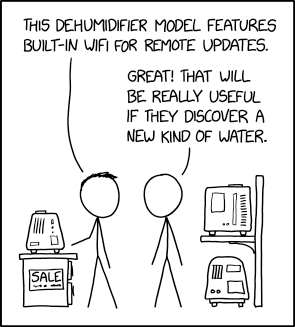Selfhosted
A place to share alternatives to popular online services that can be self-hosted without giving up privacy or locking you into a service you don't control.
Rules:
-
Be civil: we're here to support and learn from one another. Insults won't be tolerated. Flame wars are frowned upon.
-
No spam posting.
-
Posts have to be centered around self-hosting. There are other communities for discussing hardware or home computing. If it's not obvious why your post topic revolves around selfhosting, please include details to make it clear.
-
Don't duplicate the full text of your blog or github here. Just post the link for folks to click.
-
Submission headline should match the article title (don’t cherry-pick information from the title to fit your agenda).
-
No trolling.
Resources:
- selfh.st Newsletter and index of selfhosted software and apps
- awesome-selfhosted software
- awesome-sysadmin resources
- Self-Hosted Podcast from Jupiter Broadcasting
Any issues on the community? Report it using the report flag.
Questions? DM the mods!
view the rest of the comments

That’s a very cool feature actually but how does it stop a hacker if he has obtained a trusted MAC address from another device and connect to vlan 20 directly while the real device is offline?
You configure vlans per physical port, so in a properly implemented system your attack won't be possible. When the packet comes to the switch the vlan tag is added to it according to the configuration for the port it was received from.
Or are you talking about mac-vlans?
Ok maybe I don’t fully understand yet. Let’s say an access point has 3 SSIDs, lan, guest and iot each client on each SSID gets a vlan tag accordingly. So it’s only connected to a single physical port, i think that’s what confused me. But SSIDs are interfaces just like an physical port afaik so your analogy still stands. The security here is the WiFi password anything that connects to LAN gets a LAN vlan tag. but it’s not like anything that connects to any of the SSIDs can get the DHCP lease of some random device on any vlan cuz it got tagged before. Or am I missing something?
That sounds accurate. I have all my devices assigned a specific IP address, based on their MAC address, but that's only per-interface. The other interfaces aren't aware of my assignments for each other.
If I connect my phone to my LAN SSID, it'll get its assigned IP, but if I connect it to the NOT [network of things, no internet access] SSID, it'll get assigned a new address out of the DHCP pool because I haven't assigned it an IP on that interface, until I assign it an IP. But, which VLAN it's connected to will determine which IP its getting, and it still requires me to know the passwords for each SSID.
I believe where you're getting confused is that a some businesses (or homelabs) might use a RADIUS server which will be more like this: ONE_SINGLE_SSID-Broadcast -> Device connects -> RADIUS Server detects account/certificate/MAC -> RADIUS Server assigns interface -> Device connects to VLAN the RADIUS server granted it access to
So, in that scenario, if the ONLY thing that's being used to validate the access is the devices MAC address, just changing the MAC address will effectively grant a completely different level of access with nothing else changing. Most people in a homelab (and even plenty of larger businesses) aren't running the infrastructure to do this though, they're just effectively connecting a VLAN to a port and then that port can only be used to connect to that VLAN. They're doing the same with the WiFi SSIDs where each SSID connects directly to the VLAN.
Usually though, for places that are implementing the RADIUS server, they'll also install a certificate on their devices and the certificate needs to be in place in order to get certain access otherwise the RADIUS server will authorize less permissive access or just won't allow access at all. Or, it'll also need a user to log in to gain additional access.
For wired, the company may also implement port locking where the port will only allow a certain amount of MAC addresses to connect (presumably one unless there is also a VOICE VLAN with a phone being used, in which case it'd be two) where if you change your MAC address (or connect a different device), the port will lock and won't power POE devices and won't allow connectivity until an admin clears the lock. It's possible that they may have multiple VLANs allowed on the port and client side you can change VLANs, but, this isn't typically done on all ports, usually only on trusted ports or ports that need the multiple VLANs (my VM server for instance has access to a port that'll allow multiple VLANs and I just enter the tag I need when I create the VM). This would be similar to your WiFi scenario, the port with the WAP connected to it will have access to multiple VLANs and then those WLANs just connect to the VLAN that they're assigned to.
TL;DR - Typically one wireless SSID connects to one VLAN and if you want to jump to the other VLAN you'd need to connect to the other SSID, so you still have the individual passwords protecting you. On wired, typically VLANs are assigned per port and you can't jump between then, but where they aren't, it should be in a planned way and not just every port having access to every VLAN. Bad implementations exist though, so, anything is possible.